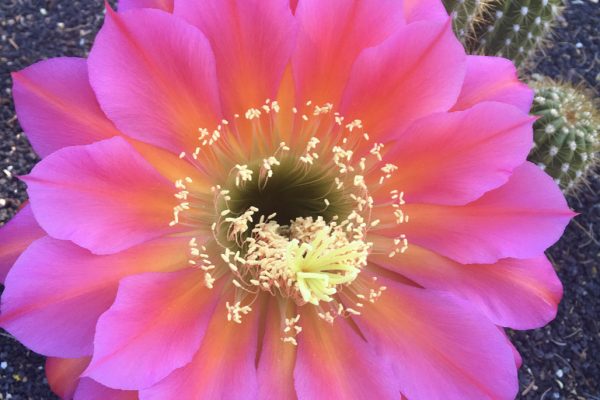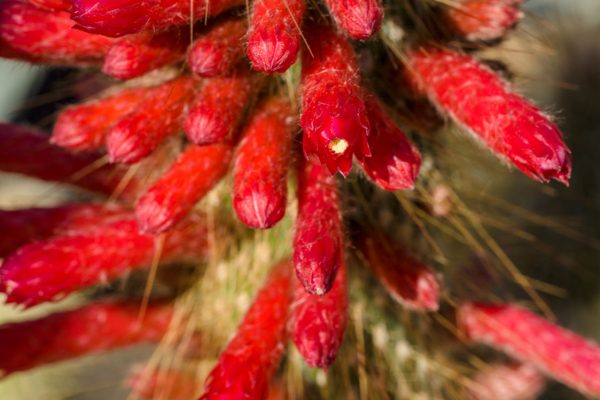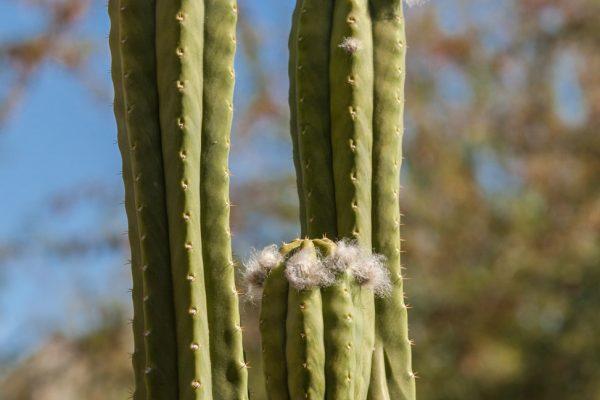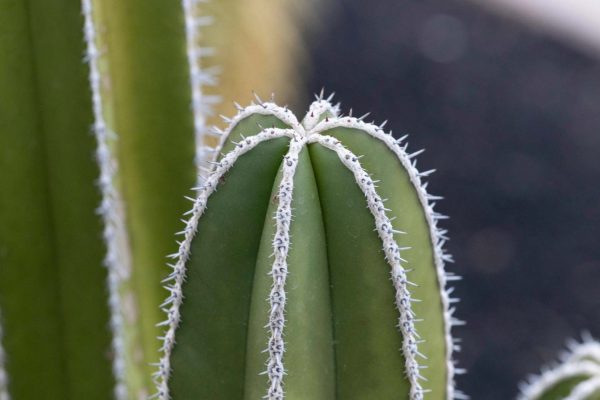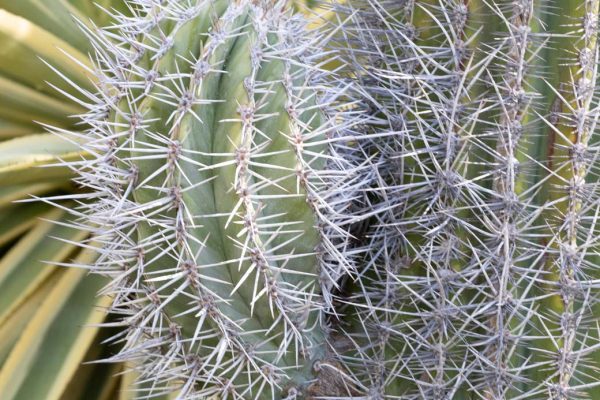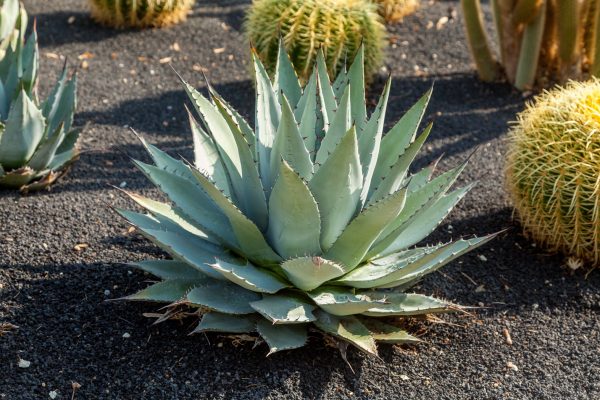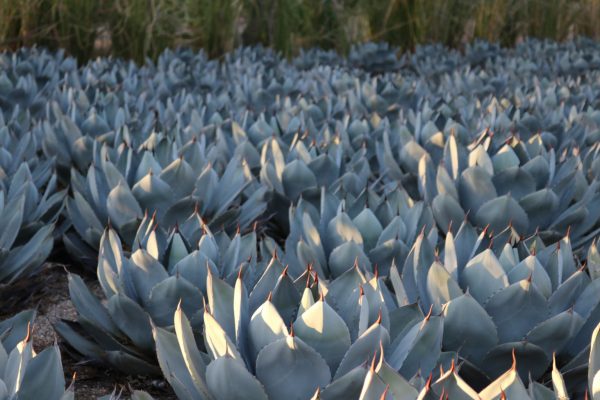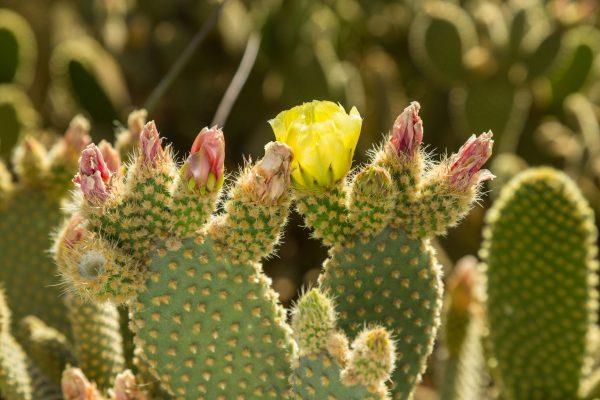
Bunny Ear is found along the path that surrounds the wildflower field and in the specimen beds between the café and solar field. It is a beautiful example of the Opuntia genus, displaying small pads with spines placed close together that give it a fuzzy appearance.
With a common name that evokes a soft and cuddly image, Bunny Ear is a very misleading cactus. The fuzzy hairs on its pads are not soft and touchable. They are groups of spines known as glochids, which are small but strong in bite if you mistakenly brush against them. They are delicate and break off easily at the skin’s surface, but their barbed spines, left embedded in the skin, are very difficult to retrieve. The pain from the almost invisible embedded spines can last for days, sending a stinging sensation each time that part of the skin is touched.
REMOVAL OF GLOCHIDS: If you accidentally touch this cactus, do not attempt to wipe off the glochids, as they can attach to other parts of your skin, causing additional wounds. The best removal strategy is duct tape. Though it may not get all the spines, it is an effective remedy for most. Tweezers and a magnifying glass are good tools to remove the rest.
Bunny Ear blooms in the warmer months. Soft yellow cup-shaped blooms will appear, which are a delight to many pollinators. North and South American desert plants have a unique pollination strategy with native bees. Rather than using leg pouches like honeybees, solitary bees roll around in the flower cups, covering themselves in pollen to be distributed at their next stop. Catching them in the act is a delight, reminiscent of a dog rolling in grass.
Native and endemic to northern and central Mexico.
This smaller columnar cactus is in the specimen beds between the café and solar field and will grow to about 3 feet. It is a very attractive columnar cactus—perfect for small gardens or several planted in a larger space.
The varietal name grandiflora is no joke! It produces huge blooms and, with a variety of hybrids on the market, it is available in many colors, including pink, red, yellow, and bright fuchsia. When in bloom, they stop visitors in their tracks.
Previously named Lobivia grandiflora or Trichocereus grandiflorus.
Torch originates in Catamarca, Argentina.
The best place to identify this species is in the specimen beds near the shuttle gate, though there is one in the specimen beds by the café. This cactus has a hefty stem diameter and a heavy covering of hair-like spines, which is where the common name Old Lady originated. Edward F. Anderson’s 2004 edition of The Cactus Family does not give this species a common name, but it is referenced elsewhere as Old Lady.
The Espostoa genus has not been studied extensively and many species will likely be reclassified through future phylogenics (gene study).
Greenish-white to red colored fruit will follow white bell-shaped flowers.
Distribution is northern to central Peru.

The specimen beds near the café have several Silver Torch cacti. The original planting included the species strausii, but clearly there are some other varieties from within the genus, and possible hybrids displaying a range of bloom color and spine distribution.
Silver Torch displays an abundance of spines on thin, cylindrical stems. It grows to about 10 feet. In the botanical genetics field, there is still some disagreement as to what should be included in the Cleistocactus genus, so as cactus are sorted more specifically along genetic lines rather than botanist observations, we will see new groupings in the future.
Red blooms can occur on Silver Torch Cactus throughout the year. At Sunnylands, the blooms emerge between red and orange, but generally the plant can flower with yellow and green blooms, too. The flowers barely open, and it is from this they get the name of the genus, Cleistocactus, as Kleisto in Greek means, “closed.” This tightly wrapped bloom may show some diversity, growing both straight and curved on different species. The blooms have a beak shape that closely accommodates the beaks of the hummingbirds that pollinate them. Birds with larger beaks would have difficulty. Flower design clearly shows preference when it comes to pollinators. In this case, it’s the hummingbirds that are preferred.
The genus of Cleistocactus extends throughout Argentina, Peru, and Bolivia.
San Pedro is planted throughout the gardens. You can see it in the specimen beds, in spotlight beds around the wildflower field, and the lower garden path. This is a columnar variety with very small spines spaced along the rib margins. In some cases, the spines are completely absent. Native at much higher elevations than Sunnylands, it nevertheless seems to thrive on the desert floor, as it is one of our most prolific bloomers.
The fragrant, white blooms open at night to await the nocturnal pollinators, bats, and moths.
The large, funnel-shaped blooms remain open the next morning, finding themselves the host of native bees who are completely engulfed by the long, pollen-covered stamens. The bees disappear into the bloom and re-emerge, speckled yellow.
San Pedro is native to Ecuador and Peru, where it is used extensively by indigenous cultures for medicine.
This columnar cactus is in the specimen beds nearest the shuttle gate. It is easy to identify with the solid white margin along ribs that display its spines.
Like the Cardon cactus, Fencepost is part of the Pachycereus genus. The common name of Fencepost references its cultivation to create living fences. With a maximum height around 16 feet, it does make a formidable barrier when placed close together.
Mature specimens bloom red, funnel-shaped flowers with pink interiors in rows down the rib margins.
Fencepost’s distribution is in Mexico, and includes the states of Hidalgo, Guanajuato, Querétaro, Morelos, Puebla, Oaxaca, Colima, Michoacán, and Guerrero.

Cardon can grow to 36 feet, and its spines are gray to white. There are three Cardon in the specimen beds nearest the solar field. They are still quite young and were less than 5 feet tall when planted during the original installation.
The Cardon is part of a family that consists of over 12 other large columnar cactus species under the genus Pachycereus (Greek for “thick” and “torch”). These botanical groupings for cactus are a bit fragile, and more phylogenic (genetic tracing) work needs to be completed. Not all cactus have had their genetic connections confirmed. In some groupings, they do not share the same taxonomic features and may later be determined to be unrelated. For now, they are grouped based on similar size and their candelabra structure. There are three species in the gardens that fall into this genus: Cardon, Fencepost, and Totem Pole.
When mature, they will display funnel-shaped, white flowers that will bloom both day and night, attracting multiple pollinators. This genus Pachycereus also has significant ethnobotanical uses by desert native cultures.
Distribution of Cardon includes the Sonoran Desert states of Sonora, Baja California, and Baja California Sur in Mexico. The Baja location is why it can be referred to as Baja Saguaro.

This is the description for Parry’s Agave, but there is also an Agave parryi var. ‘truncata.’ For this variety, please see Artichoke Agave.
The Parry’s Agave is a small, neatly designed variety with elliptical leaves arranged in a tight rosette. It is one of the more common agaves in the garden. It can colonize forming offsets around its base. So, in addition to seed collection, these clones can be collected, and at Sunnylands they are harvested for future specimen replacements. It is a perfect companion for wildflowers and perennials in desert gardens, but is equally successful in groupings of several Parry’s Agave. It is one of the most cultivated species for low-desert gardens.
Parry’s Agave grows an inflorescence (flowering stem) that may rise up to 20 feet, extending branches that will hold bright yellow flowers, touched with red or pink.
It’s origins include Arizona, New Mexico, and the Mexican states of Chihuahua and Durango at an elevation range between 1,500 and 8,000 feet, but it has done equally well on the desert floor. The vast range of this species allows it to thrive in many locations.
One of our most popular plants at Sunnylands is the truncated variant of Parry’s Agave. When visitors hear its common name is Artichoke Agave, the response is an instant head nod and verbal agreement—of course! It displays a tight, perfectly round rosette that is reminiscent of an artichoke bloom. Its arrangement in uniformed rows at Sunnylands draws the eye to its oval, blue-green leaves.
Like other parryi varieties, Artichoke Agave is versatile in garden design, pairing gracefully among wildflowers and perennials, or stealing the show in groupings. It adapts well to both desert floor and hillside gardens, making it a great choice for any space.

